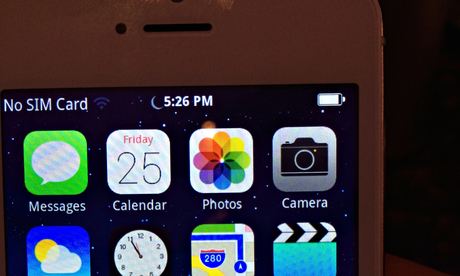If China is the world's workshop, then Shenzhen is its hi-tech manufacturing hub. It is home to Foxconn, Apple's main supplier, whose gigantic factories are just outside the city, and thousands of other production lines churning out thousands of other hi-tech products.Workers are housed in dormitory and high-rise blocks. Shenzhen's permanent population is just 2m - but that is boosted to nearly 11m by migrant workers from all over the country who often travel hundreds of miles for short-term work.
But there is a flipside to China's ability to mass-produce complex goods at a low cost for ravenous western consumers – and it is visible on any carriage on the Shenzhen metro.
As the train doors close, Ian Fogg, senior electronics analyst at research company IHS, notes the number of what appear to be iPhone-wielding commuters. Many, however, are fakes assembled from commercially sensitive blueprints – a time-honoured gripe among western businesses in China. "You can't be sure," says Fogg. "You have to get much closer to spot the fakes."
Hours later, Peter Richardson of Counterpoint Research, who was also visiting Shenzhen, pulled a phone from his pocket: "Look at the iPhone 5S I got for 800 renminbi [about £75]."
The price is alluring, but it is fake. The phone is convincing enough at first glance: it looks real and the home screen icons look familiar. But open the settings menu and the font is different – fatter and fuzzier – while some items (notably "privacy") are missing. And looking closer at the phone itself, the top has been glued on and imperfectly finished. It is a fake, running AOSP, the open-source version of Android.
"When I used to work for Nokia and came here, we had to recast how we counted product in the market," says Richardson. "We had to start taking account of the fakes in how we counted sales and penetration because there were so many."
But times change. "This time, the only fakes I saw were iPhones, a few Samsung Galaxy S5s and some Vertu models" – the latter being the costliest phones in the world, with starting prices of around £4,000.
Richardson acquired his fake phone from a tower block complex of independent retailers and little shopfronts: Huaqiangbei (pronounced Hang-shao-bay).
Inside you can buy anything electronic, as one-offs or in industrial quantities. One glass-topped stand held what looked like film reels – dozens and dozens of them. Wondering why an electronics mart would sell celluloid, I looked closer – and realised that what I had taken to be the cels of the film were actually chips embedded in protective plastic. The reels were thousands of integrated circuits – dedicated chips for functions such as voltage regulation, or signal processing, or any task you can perform with microelectronics. But it's the fakes that draw the eye. Richardson took photos of an array of fake iPhones in one of the glass displays. Fogg, meanwhile, pointed to another set under a glass counter: "Look at the 'i' in 'iPhone'," he said. Closer examination showed that the initial letter was very slightly askew - the telltale indicator of a fake. In another shop, people were assembling phones. In another, they were repairing.
The shelves are packed: iPhones, Samsung phones, as well as headphones – some bearing the "b" logo of Beats by Dr Dre – and LED lights, disk drives and memory chips. Adapters bearing the Apple logo – but almost certainly not the real thing – abound. A UK website recently did a comparison of the safety aspect of a counterfeit and real iPad charger: the fake was far cheaper, but actually only generated half the power, and lacked a number of key safety elements.
"In rough terms, we think around one quarter of the 1.1bn smartphones shipped in 2013 originated in Shenzhen," says Richardson. "Most of these are perfectly good, high-quality products, including real iPhones made by companies like Foxconn." But he adds that there are probably tens of millions of "illegitimate" handsets – fakes or unbranded products with no IMEI (international mobile equipment identity) numbers.
Some of those are exported, but the chances of them ending up in Europe or the US are slim, due to tight customs checks.
But, says Richardson, the fake business may be peaking: "The economic incentive to make them is fading." Whereas Nokia or BlackBerry phones used to be clearly differentiated, most smartphones now are near-identical black slabs running AOSP. That makes it more profitable, and less risky, to manufacture them for any of the dozens of local handset makers, who are seeing demand explode from a population that has bought nearly 200m smartphones in the past six months alone.
"Legitimate Android smartphones are falling in price fast," says Richardson. "They're easily less than $50 wholesale now, and could hit $25-30 by the year-end."
• This article was amended on 16 May 2014. The earlier version referred to "microprocessors" where it should have said "integrated circuits", and "any task you can perform digitally" where it should have said "any task you can perform with microelectronics".











